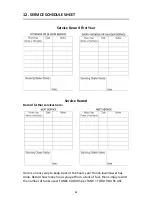
50
8. MAINTENANCE - continued
Carburettor Modification for High Altitude Operation
At high altitude, the standard air-fuel mixture will be too rich. Performance
will decrease and fuel consumption will increase. A very rich mixture will also
foul the spark plug and cause hard starting.
High altitude performance can be improved by specific modifications to the
carburettor. If you always operate your lawn mower at altitude above 1,500
metres, have your servicing dealer perform carburettor modifications.
Even with carburettor modification, engine horsepower will decrease about
3.5% for each 300 metres increase in altitude. The effect of altitude on
horsepower will be greater than this if no carburettor modification is made.
NOTICE
When the carburettor has been modified for high altitude operation, the air-
fuel mixture will be too lean for low altitude use. Operation at altitude
below 1,500m with modified carburettor may cause the engine to overheat
and result in serious engine damage. For use at low altitude, have your
servicing dealer return the carburettor to original factory specifications.
Fuel Recommendations
Use unleaded petrol with a pump octane rating of 86 or higher. This engine is
certified to operate on unleaded petrol. Unleaded petrol produces fewer
engine and spark plug deposits and extends exhaust system life. Never use
stale or contaminated petrol or an oil/petrol mixture. Avoid getting dirt or
water in the fuel tank. Occasionally you may hear light “spark knock” or
“pinging” (metallic rapping noise) while operating under heavy loads. This is
no cause for concern. If spark knock or pinging occurs at a steady engine
speed, under normal load, change brands of petrol. If spark knock or pinging
persists, see an authorised Honda servicing dealer.
NOTICE
Running the engine with persistent spark knock or pinging can cause engine
damage. Running the engine with persistent spark knock or pinging is misuse
and the Warranty does not cover parts damaged by misuse.
For Ethanol
blended or oxygenated fuel information, refer to page 38.
















































